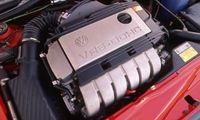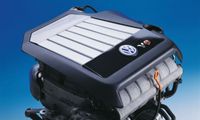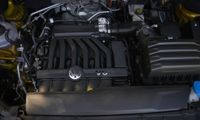The 3.2 VR6 belongs to the Audi TT 8N like the arch belongs to the roofline silhouette. On paper, it is “just” a 6-cylinder engine, but in practice it is a compact, unique engine with its own character and sound. This page takes you through the history of the VR6 within the VAG group, zooms in on the 3.2 in the Audi TT 8N (and 8J) and links to technical background documents and information about the well-known chain issues.
What makes the VR6 so special?
The VR6 is no “ordinary” V6. It is a clever mix between an inline-6 and a V6:
- Very narrow block angle: 15° between the cylinder banks. Sometimes even as little as 10.5°
- One cylinder block and one cylinder head (like an inline engine)
- Compact enough for transverse mounting in compact front-wheel drive cars
- A characteristic, full sound that many enthusiasts immediately recognise.
Volkswagen introduced the first VR6 in 1991 in the VW Golf III, among others. Since then, the 2.8-litre engine has grown to include 3.2 and 3.6 litres, and even a 2.5 VR6 with turbo for the Chinese market. A total of almost 1.87 million VR6 engines were produced before the last one rolled off the production line in December 2024.
Brief history of the VR6 within VAG
From idea to icon (2.8 & 2.9 VR6 – 12 valves)
In the 1980s, Volkswagen came up with the idea of installing a 6-cylinder engine in compact models without the space problems associated with a “normal” V6 or 6-cylinder in-line engine. The solution was the VR6: a compact, transversely mounted 6-cylinder engine with a narrow block angle.
- 1991 – Introduction of the 2.8 VR6 (12v, 174 hp) in the Corrado, Golf III and Passat B3/B4, among others
- Later – Enlarged 2.9 VR6 (190 hp), including in the Corrado and special models
When the TT concept was designed in 1995, the VR6 was already a logical and attractive idea for under the bonnet: premium positioning, lots of cylinders and a unique sound.
2.8 VR6 12v
2.9 VR6 12v
Second generation: 2.8 VR6 – 24 valves (1999–2002)
Around 1999, the VR6 was further developed to 24 valves, increasing its power to 204 hp at 2.8 litres. This version can be recognised by the red “6” in the V6 logo on various VW models.
Period | Engine | Valves | Power (hp) | Examples of models* |
1991 - 1998 | 2.8 VR6 | 12v | approx.. 174 | VW Golf III, Corrado, Passat B3/B4 |
1992 - 1995 | 2.9 VR6 | 12v | approx.. 190 | VW Corrado, VW Synchro variants |
1999 - 2002 | 2.8 VR6 | 24v | approx.. 204 | Various VW models |
2001 - 2010 | 3.2 VR6 | 24v | 224 - 250 | VW Beetle RSI, VW Golf R32, Audi TT 3.2, Audi A3 3.2 |
2005 - 2023 | 3.6 VR6 FSI | 24v | 260 - 300 | VW Passat R36, VW Touareg, VW Phaeton, Audi Q7 |
2021 - 2024 | 2.5 VR6 T | 24v | 295 - 300 | VW Talagon, VW Teramont, Audi Q6 (China) |
* selectie, niet compleet
The VR6 3.2 in the Audi TT 8N
Introduction to the TT 8N
In mid 2003, the VR6 finally arrived in the Audi TT 8N, as a 3.2-litre 24v with 250 hp and 320 Nm (engine code BHE). That was almost five years after the introduction of the production TT, but the VR6 had been on the wish list since the first concept sketches.
Key features of the TT 8N 3.2 VR6:
- Engine: 3.2-litre VR6, 24 valves
- Power: 250 hp at 6,300 rpm
- Torque: 320 Nm at 2,500–3,000 rpm
- Drive: always quattro (Haldex)
- Available as Coupé and Roadster
- Years of manufacture: 2003–2006
Versions TT 8N 3.2 VR6
Two main variants of the Audi TT 8N 3.2 were introduced:
- 07-2003 – Audi TT 8N 3.2 V6 250 hp quattro DSG-6
- 01-2004 – Audi TT 8N 3.2 V6 250 hp quattro 6-speed manual
- Power: again 250 hp and 320 Nm
- Drive: quattro
- Available in both Coupé and Roadster versions
This made the TT 3.2 a true “halo version”: the top model with 6 cylinders, four-wheel drive and a DSG gearbox that was very modern for its time.
TT 8N 3.2 in figures
A total of 14,490 Audi TT 8N models with 3.2 VR6 engines were built, all in Győr (Hungary):
Type | Production | Number |
TT 8N 3.2 Coupé | 08/2003–05/2006 | 10,370 |
TT 8N 3.2 Roadster | 09/2003–06/2006 | 4,120 |
Total | 14,490 |
VR6 3.2 in the Audi TT 8J
The second generation TT, the Audi TT 8J, also received a 3.2 VR6, now with engine code BUB.
- Power: again 250 hp and 320 Nm
- Drive: quattro
- DSG and 6-speed manual transmission
- Available in both Coupé and Roadster versions
The technology is closely related to the 3.2 VR6 in the TT 8N, Golf R32 and A3 3.2, but packaged in the more modern 8J body.
The 3.6 VR6 that never made it into the TT
In 2005, the 3.6 VR6 FSI was introduced:
- Cylinder capacity: 3.6 litres
- Block angle: ~10.6°, making it even more compact than the classic 15° VR6
- Power: 260–300 hp, including in the Passat R36, Touareg, Phaeton, Cayenne and Audi Q7
This 3.6 never officially made it into the TT – not even as an 8J. However, it has been retrofitted into a TT 8N or 8J by a few tuners and specialists as a serious conversion. There are known projects (such as by Bigwheelers Engineering in Waren/Müritz) in which a TT 8N has been fitted with a 3.6 VR6 swap.
2.5 VR6 Turbo – the last of the Mohicans (2021–2024)
The very last VR6 generation was the 2.5 VR6 with turbo, exclusively for the Chinese market. This engine was supplied in:
- Volkswagen Talagon 2.5 VR6
- Volkswagen Teramont 2.5 VR6
- Audi Q6 2.5 VR6 (50 TFSI quattro)
Specifications:
- Engine capacity: 2.5 litre VR6
- Power: around 295–300 hp
- Torque: approx. 500 Nm
End of VR6 production in 2024 |
VR6 sound in the Audi TT
Much of the charm of the TT 3.2 VR6 lies in the experience:
- The typical ‘growl’ at low revs
- The full, singing tone at higher revs
- In combination with the DSG gearbox, the characteristic ‘blips’ when down shifting
Curious to hear how a standard TT 8N 3.2 VR6 sounds?
👉 Download here the VR6 sound
Meer (technische) detailinformatie over de VR6 3.2
For true enthusiasts, there is often not enough information available:
- There is an online reference work (±41 pages) with all the technical details about the Audi TT VR6 3.2.
- Overviews of specifications, connection diagrams, maintenance intervals and typical points of attention.
📄 Download here het 41-page-long reference work.
VR6 3.2 chain problems
The 3.2 VR6 is known for potential problems with the timing chain and associated guides and tensioners. Especially at higher mileage and/or poor maintenance, this can lead to rattling noises and expensive repairs. A comprehensive German report (157 pages, from 2009) takes an in-depth look at the chain problems of the 3.2 VR6. It includes technical background information, many practical examples and advice on how to prevent problems or identify them in good time.
📄 Download here the the complete chain report (German).
© Headerfoto: unknown







